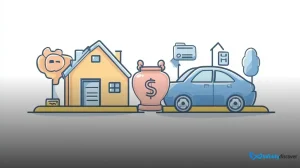If you’re struggling with bad credit, securing a loan might seem difficult, but it’s not impossible. Many lenders offer loans for bad credit, providing financial relief to individuals facing challenges with traditional borrowing. These loans help borrowers rebuild their financial standing while offering much-needed support in times of need.
Understanding the available options is essential when looking for loans for bad credit. Some lenders focus on flexible terms, while others offer secured or guarantor loans to reduce risk. Interest rates and repayment plans vary, so comparing different options can help you find a solution that fits your financial situation.
How can you find the best loans for bad credit and improve your chances of approval? Exploring different lenders, understanding eligibility requirements, and managing your finances wisely can help you secure a loan while working toward better credit.
Understanding Loans for Bad Credit
Understanding loans for bad credit is essential for anyone facing financial difficulties. These loans are designed specifically for individuals with a less-than-perfect credit history. Traditional lenders often turn away applicants with poor credit, making it challenging to secure the funds needed for unexpected expenses or urgent bills. Thankfully, there are lenders willing to provide bad credit loans to help you meet your financial obligations.
What are Bad Credit Loans?
Bad credit loans are financial products available to those with low credit scores. They can come in various forms, including personal loans, payday loans, and secured loans. Each type serves different needs and comes with its own terms. It’s important to understand how each loan type works before making a decision.
Who Should Consider Bad Credit Loans?
If you have a credit score below 600, you may struggle to find traditional lending options. People facing medical expenses, car repairs, or urgent home repairs often turn to loans for bad credit as a way to cover these costs. However, it’s crucial to assess your financial situation and ensure you can repay the loan.
Advantages of Loans for Bad Credit
One of the main advantages of loans for bad credit is accessibility. These loans can help rebuild your credit if you make timely payments. Additionally, they provide quick cash when you need it most, which can help alleviate immediate financial pressures.
Considerations Before Taking a Bad Credit Loan
Before applying for a bad credit loan, it’s vital to read the fine print. Interest rates on these loans can be higher than average due to the increased risk for lenders. Always compare offers and fees to find the best deal for your situation.
In Conclusion
Understanding loans for bad credit opens doors for those needing financial assistance. By exploring your options, you can find solutions that support your needs while managing the implications for your credit. Make informed decisions and, if possible, seek advice from a financial professional to ensure the loan you choose is right for you.
Types of Bad Credit Loans
When exploring types of bad credit loans, it’s essential to understand the options available. Each type serves different purposes and has unique features. Knowing these can help you make informed decisions.
1. Personal Loans
Personal loans are versatile and can be used for various expenses like medical bills, home repairs, or debt consolidation. Lenders may offer secured or unsecured options, but those with bad credit might face higher interest rates on unsecured loans.
2. Payday Loans
Payday loans are short-term loans that provide quick cash until your next paycheck. While they’re easy to obtain, they can have extremely high interest rates and minimal repayment terms. Caution is advised when considering this option.
3. Title Loans
Title loans are secured loans where you pledge your vehicle as collateral. This means that if you fail to repay, you could lose your car. Title loans typically have high interest rates, so ensure you understand the risks involved.
4. Peer-to-Peer Loans
Peer-to-peer lending platforms connect borrowers directly with individual lenders. This option may offer better rates and terms than traditional loans, but requirements can vary based on the lender’s assessment of your creditworthiness.
5. Credit Union Loans
Credit unions may offer loans for bad credit at lower interest rates than traditional banks. If you are a member of a credit union, consider discussing your options with them, as they often have more flexible lending criteria.
6. Cash Advance Credit Cards
Cash advance credit cards allow you to withdraw cash against your credit limit. However, cash advances often come with high fees and interest rates from the day you withdraw, making them a costly option.
7. Bad Credit Mortgage Options
For those looking to buy a home, there are mortgage options designed for low-credit borrowers, such as FHA loans. These loans often have lower credit score requirements, making them accessible for many.
How to Apply for Bad Credit Loans

Applying for bad credit loans can be daunting, but knowing the steps can make the process smoother. Follow these guidelines to navigate your application successfully.
1. Check Your Credit Report
Before applying, review your credit report. This will help you understand your credit situation and identify any errors that could be corrected. You are entitled to a free report once a year from each of the major credit bureaus.
2. Research Lenders
Not all lenders cater to bad credit borrowers, so it’s important to research options. Look for lenders that focus on bad credit loans. Compare interest rates, terms, and conditions to find a suitable option.
3. Gather Required Documents
Prepare the necessary documents needed for your application. Common items include: proof of income (paystubs or bank statements), identification (driver’s license or passport), and details about your monthly expenses. Having everything ready can speed up the process.
4. Fill Out the Application
Once you’ve chosen a lender, fill out the loan application accurately. Be honest about your financial situation. Many lenders offer online applications, which can be convenient and faster.
5. Review the Offer
After submitting your application, you will receive a loan offer if approved. Carefully review the terms, including the interest rate, repayment period, and any fees. If it does not meet your needs, don’t hesitate to negotiate or seek other options.
6. Sign the Agreement
If you agree with the loan terms, proceed to sign the agreement. Ensure you fully understand the repayment schedule and any consequences of late payments or defaults.
7. Access Your Funds
After signing the agreement, you will typically receive your funds within a few days. Depending on the lender, funds can be deposited directly into your bank account or issued via check.
Tips for Improving Your Credit Score
Improving your credit score is essential for accessing better financial options and securing loans. Here are some effective tips to help enhance your credit rating.
1. Pay Your Bills on Time
Timely payments are crucial for a good credit score. Set reminders or automate payments to avoid missing due dates. Even one late payment can negatively affect your score.
2. Reduce Your Credit Card Balances
Keep your credit utilization ratio, which is the balance on your credit cards compared to your total credit limit, below 30%. Paying down existing balances can significantly boost your score.
3. Avoid Opening New Accounts Frequently
Each time you apply for credit, a hard inquiry is made on your report, which can lower your score. Limit new applications, especially if you’re trying to improve your credit.
4. Check Your Credit Report Regularly
Regularly review your credit report for errors or inaccuracies. If you find mistakes, dispute them with the credit bureaus. Correcting errors can lead to score improvements.
5. Diversify Your Credit Mix
Having a variety of credit types—such as installment loans, credit cards, and retail accounts—can be beneficial. A diverse credit mix shows lenders that you can handle various types of credit responsibly.
6. Keep Old Credit Accounts Open
Closing old credit accounts can lower your credit history length and utilization ratio. Keep these accounts open, even if you do not use them often, to help maintain a longer credit history.
7. Seek Professional Help if Needed
If you’re struggling to improve your credit score on your own, consider consulting a credit counseling service. They can provide personalized guidance and strategies.
Alternatives to Bad Credit Loans

If you’re struggling to secure a bad credit loan, there are several alternatives to consider. These options might be more suitable for your needs and could help you avoid high-interest rates often associated with bad credit loans.
1. Credit Union Loans
Credit unions often offer personal loans at lower interest rates compared to traditional banks. They tend to be more flexible with their lending criteria, making them a good option for those with bad credit.
2. Peer-to-Peer Lending
Peer-to-peer lending allows you to borrow money directly from individuals through online platforms. These loans can have competitive rates, and the process may be more lenient on credit history than banks.
3. Secured Loans
Secured loans require collateral, such as a car or savings account. Because they pose less risk to lenders, secured loans often come with better interest rates compared to unsecured loans.
4. Borrowing from Friends or Family
If possible, consider borrowing from friends or family. This option can have more flexible repayment terms and lower or no interest. Make sure to put any agreement in writing to avoid misunderstandings.
5. Side Jobs or Gig Work
Taking on temporary jobs or freelance work can provide extra cash quickly. Websites like Upwork or Fiverr offer opportunities to earn money based on your skills, helping you avoid loans altogether.
6. Emergency Hardship Programs
Some nonprofit organizations and charities offer financial assistance for specific needs. These programs can provide funds for emergency situations and often do not require repayment.
7. Government Assistance Programs
Check if you qualify for government programs that can offer financial aid or low-interest loans. These programs are designed to help those in financial hardship and may be more accessible than traditional loans.
Understanding Your Options with Bad Credit Loans
While securing a loan with bad credit can be challenging, it’s important to know that options are available. From understanding the different types of loans tailored for those with poor credit to exploring alternatives that might be more beneficial, being informed is key.
Following the tips to improve your credit score and avoiding common mistakes can enhance your financial future significantly. Additionally, familiarizing yourself with frequently asked questions helps to demystify the lending process and empowers you to make better decisions.
Whether you choose a bad credit loan or an alternative option, ensuring you have all the necessary information will set you on the path towards achieving your financial goals.





